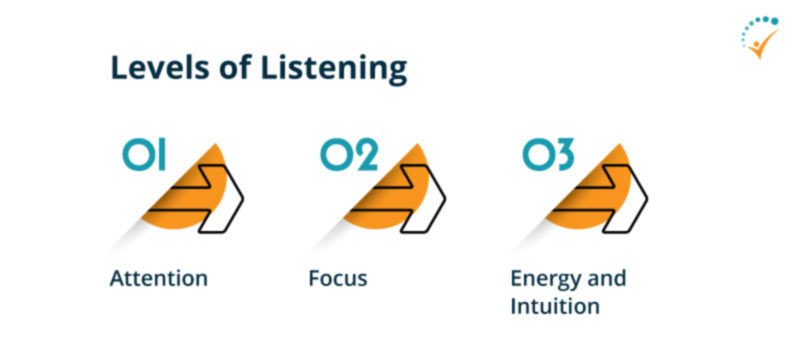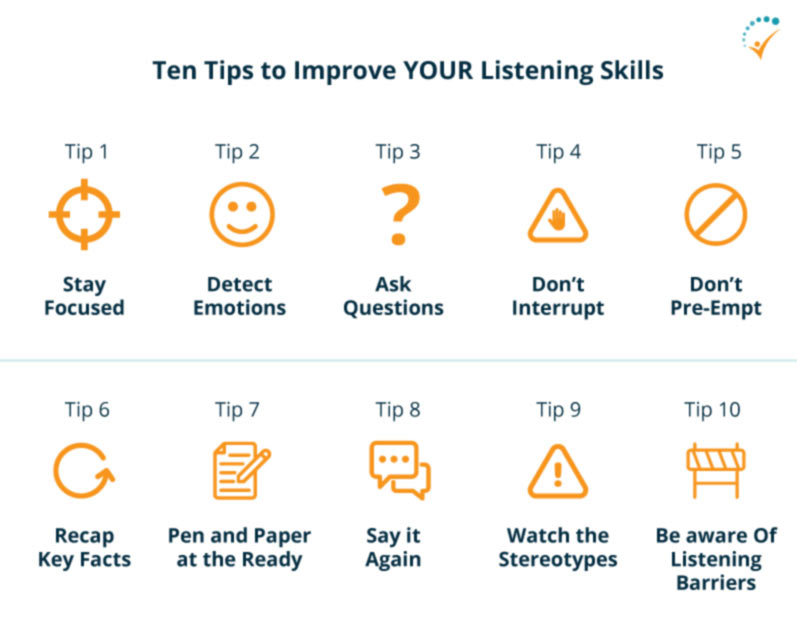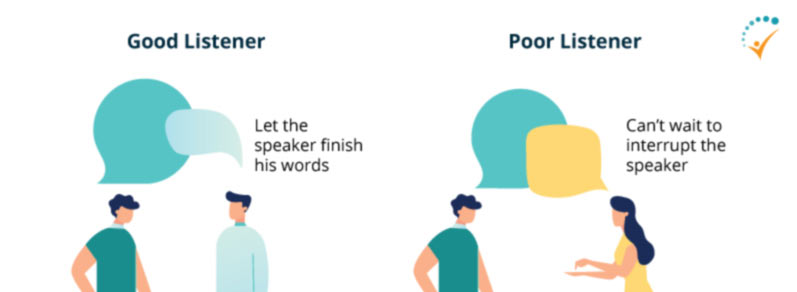"One of the most sincere forms of respect is actually listening to what another has to say." --Bryant H. McGill
Listening is the way we connect with people. They can tell when the connection is there and will be more open to sharing and trying new ideas with you. Engaged Listening helps us to give full attention to the words, nuances, and unspoken meaning of our clients’ communication.
Levels of Listening (As per Co-active Coaching Book)

Level I – Attention is on ourselves. Dialogue is all about us, not about the person we’re talking with.
Level II – Focus is on the other person, their words, tone, pace, feelings, and even what is not said.
Level III – Goes way beyond words. Involves energy and intuition, all the senses.
Definition
Give full attention to the words, nuances, and the unspoken meaning of the client’s communication. The coach is more deeply aware of the client, his or her concerns, and the source of the issue by listening beyond what the client is able to articulate. - International Association of Coaching
Why is this important?
Listening is the way we connect with people. They can tell when the connection is there and will be more open to sharing and trying new ideas with you.
What Does Engaged Listening Mean?
- When we are using the skill of engaged listening, we give full attention to the words, nuances, and unspoken meaning of our clients’ communication.
- We listen beyond what our clients can articulate their concerns and the sources of their issues.
- We help them gain clarity and perspective by noticing and inquiring about the unspoken elements.
- We listen without an agenda. (Not even being busy crafting what we’ll say next.)
Results
- Clients feel understood and validated, not judged.
- Clients communicate more effortlessly and resourcefully
A bonus for you is that you gain confidence in your coaching as you discover and develop your strengths in these masteries. You become a better coach and a better communicator.

What do we listen for?
Clients provide lots of clues about what’s going on with them during a coaching session. When you are truly listening and attuned to them, you’ll notice these:
- Body language, if we can see them.
- A sudden intake of breath – a little gasp. (They may have had a flash of insight.)
- The tone in their voice sounds hesitant and unsure.
- Answer may seem too fast, without energy, almost robotic. (There may be a “should” at work.)
- The energy of their voice or manner changes. They may sound more or less relaxed than they did before you asked the question. What’s going on for them? Ask.
- Be aware of silences. Sometimes a pause will be significant. Sometimes your client is simply taking time to think. Let your intuition guide you here.
- Caution: Don’t jump in to fill the silence. Give the person space to be in the moment.
The illustration below clearly explains why it is essential for an Agile leader to be an active listener and the traits he must possess.

Sample Effective Behaviors
The coach:
- Is silent or uses nominal cues to give the client the opportunity to reflect or respond.
- Notices nuances in the client's communications.
- Confirms the client’s communications, providing an opportunity for the client to review what he/she said.
- Identifies discrepancies between what the client is saying (words) and the client’s behavior and/or emotions.
- Discerns the appropriate coaching method to use based on the client’s needs and concerns.
Sample Ineffective Behaviors
The coach:
- Interrupts inappropriately or talks over the client.
- Do not allow productive silence (such as consistently speaking as soon as the client finishes speaking).
- Misses the client’s deeper points in the communication.
- Disregard something important.
- Uses an approach that is generic and formulaic rather than adapting coaching methodology to the needs of the client.
- Focuses on making his/her point vs. listening to the client’s communication at multiple levels.

Where do these Coaches make mistakes?
Let’s take a quick look into the common blunders committed by Agile coaches, more correctly, coaches who aren’t the best of listeners-
- Not allowing productive silence
- Jumping in or interrupting your client
- Being uncomfortable with silence and thinking you need to speak if your client’s not talking
- Assuming you know what your client means (Clarify through asking and/or paraphrasing.)
- Being self-conscious about “getting coaching right” (Remember, coaching is not about you.)
- Missing deeper points of the communication; disregarding something important
- Using a formulaic approach rather than adapting to the needs of this client right now
- Focusing on making your point vs. listening to your client’s communication on multiple levels
- Not noticing or acknowledging a mismatch between clients’ behavior and what they’re saying.
COACHING IN THE TEAM CONTEXT
A key difference between coaching individuals and coaching a team is that you need to be listening to multiple voices, not just one individual.
- Are some individuals participating while others hold back? Is this a pattern? Notice and ask about things like this.
- ADVICE: It’s wisest not to single out someone who’s not participating during the meeting.
Talk to them, later, and be curious about why they chose not to participate.
- How can you be present with multiple individuals?
- Encouraging the practice of one person speaking at a time.
- Make eye contact with everyone. Observe voice, tone, energy, posture.
USEFUL QUESTIONS
While this is about listening, we still need questions. Your clients only know you heard them by what you say next.
This sort of question conveys listening and helps you listen more:
- “You mentioned [whatever] in a way that sounded important. Can you say more about that?”
- “Let me see if I understood you on that. [Share your understanding, briefly.] Is that right?”
- If you’re not right, they’ll clarify for you. Not a problem. You need to understand.
- “You mentioned [whatever]. Does it make sense to talk about that?”
- “You sound really confident when you speak about that. Where does that come from?”
- This may spark some insight that they are further ahead than they believe they are.
- “Wow! That’s a lot of info. What do you think is the most important aspect?”
- When they’ve been thinking out loud and done a big long ramble, help them focus on what was the key element, the core issue, etc.
As an Agile coach, if you are still struggling to become a good listener, here a few useful tips to improve your listening skills.

So, are you ready to be the best coach and listener? Gear up today!
Find Our Upcoming Trainings










